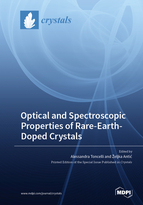Optical and Spectroscopic Properties of Rare-Earth-Doped Crystals
A special issue of Crystals (ISSN 2073-4352). This special issue belongs to the section "Inorganic Crystalline Materials".
Deadline for manuscript submissions: closed (15 June 2022) | Viewed by 28975
Special Issue Editors
Interests: photonics; rare-earth luminescence; optical spectroscopy; THz spectroscopy; crystal growth
Special Issues, Collections and Topics in MDPI journals
Interests: luminescence; luminescence thermometry; phosphors; advanced optical materials; sensors
Special Issues, Collections and Topics in MDPI journals
Special Issue Information
Dear Colleagues,
Photonics applications based on rare-earth (RE) doped crystals are developing in many different fields, such as photovoltaic, laser technology, optical data storage, sensing, bioimaging, diagnosis, and therapy. RE-doped inorganic bulk materials are long been known to have luminescence emissions that are spectrally distributed throughout the whole optical range from the ultraviolet (UV) to the mid-infrared region with unique features which have made these materials very important especially for laser applications. Moreover, when grown in nanometric size, these materials exhibit peculiar behaviours for their efficiency, lifetimes, energy transfer processes, interaction with the environment, etc., which have stimulated new research devoted, on the one hand, to the physical understanding of these phenomena and on the other hand, to the development of many new applications. This Special Issue is devoted both to the study of RE-doped bulk crystal and nanocrystal materials from a scientific point of view and to the presentation of their possible applications in any field.
We invite researchers to contribute to the Special Issue “Optical and Spectroscopic Properties of Rare-Earth Doped Crystals”, which is intended to serve as a unique multidisciplinary forum covering all aspects of science, technology, and applications of RE-doped crystals starting from the growth techniques with specific attention to the emission features of these materials and their applications.
Potential topics include, but are not limited to:
- synthesis and growth of RE-doped crystals
- new host materials for efficient emission
- upconversion efficiency
- characterisation of RE-doped crystals by spectroscopic, microscopic, and other advanced techniques
- analysis of the energy transfer processes
- biomedical and imaging applications
- integrated optics applications
- photovoltaic applications
- sensing applications
Prof. Dr. Alessandra Toncelli
Dr. Željka Antić
Guest Editors
Manuscript Submission Information
Manuscripts should be submitted online at www.mdpi.com by registering and logging in to this website. Once you are registered, click here to go to the submission form. Manuscripts can be submitted until the deadline. All submissions that pass pre-check are peer-reviewed. Accepted papers will be published continuously in the journal (as soon as accepted) and will be listed together on the special issue website. Research articles, review articles as well as short communications are invited. For planned papers, a title and short abstract (about 100 words) can be sent to the Editorial Office for announcement on this website.
Submitted manuscripts should not have been published previously, nor be under consideration for publication elsewhere (except conference proceedings papers). All manuscripts are thoroughly refereed through a single-blind peer-review process. A guide for authors and other relevant information for submission of manuscripts is available on the Instructions for Authors page. Crystals is an international peer-reviewed open access monthly journal published by MDPI.
Please visit the Instructions for Authors page before submitting a manuscript. The Article Processing Charge (APC) for publication in this open access journal is 2600 CHF (Swiss Francs). Submitted papers should be well formatted and use good English. Authors may use MDPI's English editing service prior to publication or during author revisions.







